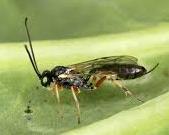Diadegma Diadegma semiclausum
Diadegma semiclausum (Diadegma) is a parasitoid wasp which lays its eggs into the developing larvae of the cabbage moth Plutella xylostella, or diamondback moth (DBM). Diadegma is the most commonly found parasite of DBM in Australia. They are strong fliers and will move quickly through a crop. Regular low level inoculations starting in late winter/early spring are very useful in establishing wasp populations and will considerably aid control of DBM.
Description and biology
Diadegma (a member of the Ichneumonidae family) is a slender black wasp approximately 5-7mm long, with prominent antennae and dark brown and yellow striped legs. Diadegma prefer to lay their eggs into very young moth larvae that have just left their protective mines in brassica leaves. Based on outward appearance, a parasitized larva looks no different to an unparasitised larva. Once they pupate, unparasitised hosts develop within a day or two while parasitized hosts remain in the early pupal stage for 2-5 days. The developing wasp spins its silken cocoon inside the cocoon of the DBM. In the late pupal stages, unparasitised moth pupae are blunt at one end, and tapered at the other and are protected within a thin silk mesh cocoon. They first appear pinky/cream then turn dark brown just prior to emergence. Parasitised pupae however are elliptical and white when first pupated, then turn grey/brown with a white band around the middle. The shed skin of the caterpillar remains as a pellet at one end of the mesh cocoon.
Female Diadegma can lay up to 800 eggs in a 25 day lifetime if a suitable sugar source is available. In the absence of honey or nectar, adults will only survive 3-4 days. At ideal temperatures of 25°C Diadegma take about 16 days to go from egg to adult, but will take up to 36 days at 15°C. Diadegma will remain active at temperatures between 12-34°C, with the ideal temperature being around 25°C.
Suitable crops
DBM are major pests of most brassica crops such as broccoli, cauliflower, cabbage, radish, canola, mustard, kale and various Asian greens. Therefore Diadegma can be released in any brassica plantings where no harmful chemicals have been used. They will be most useful when used regularly throughout the year over larger areas, or whole districts.
When to release
Two releases should occur per planting, 1 to 2 weeks apart, starting at week 2 or 3.
How to release
Diadegma are supplied as pupae on paper cards. Open the packages in the field in case some of the wasps have emerged. Cards should be placed into "release containers" obtained from Biological Services and placed out into the field. The release containers have a wick incorporated into the lid which needs to be soaked in a honey solution prior to hanging the containers in the field. This provides newly hatched wasps with a readily available sugar source (see release information sheet).
Release rates
The minimum suggested rate is 250 wasps/ha divided into 2 release points for each hectare. Release points should be spaced evenly and at least 20m from the edges of the crop to minimise the loss of wasps to adjacent areas.
Storage
Diadegma is shipped as un-emerged pupae in paper packets. Diadegma cards may be stored at 8-10°C for 1-2 days if you are unable to distribute them immediately upon receipt. However the wasps may have already started hatching when they are received, and should be released immediately. Open the packets in the field so that any emerged wasps are released in the crop.
Chemical use
Diadegma is sensitive to many pesticides, particularly pyrethroids, organophosphates and neonicotinoids. Residues on foliage may remain toxic for many weeks and negatively impact on their survival and ability to effect control. Avoid using pesticides before and during Diadegma use unless they are known to be safe. There are a range of chemicals that can assist in controlling DBM without harming Diadegma. They should be utilised in conjunction with each other. Talk to your consultant, distributor or Biological Services for more specific information relating to a compatible spraying schedule for grubs and other pests, that will not affect Diadegma establishment.
Ordering and accounts
Orders are sent via express courier services on Monday or Tuesday of each week, and usually arrive within a couple of days. Orders received after noon on Tuesday are sent the following Monday. Freight is charged at cost. Accounts are sent at the end of each month, and can be paid by EFT, BPay, cheque or postal order.








